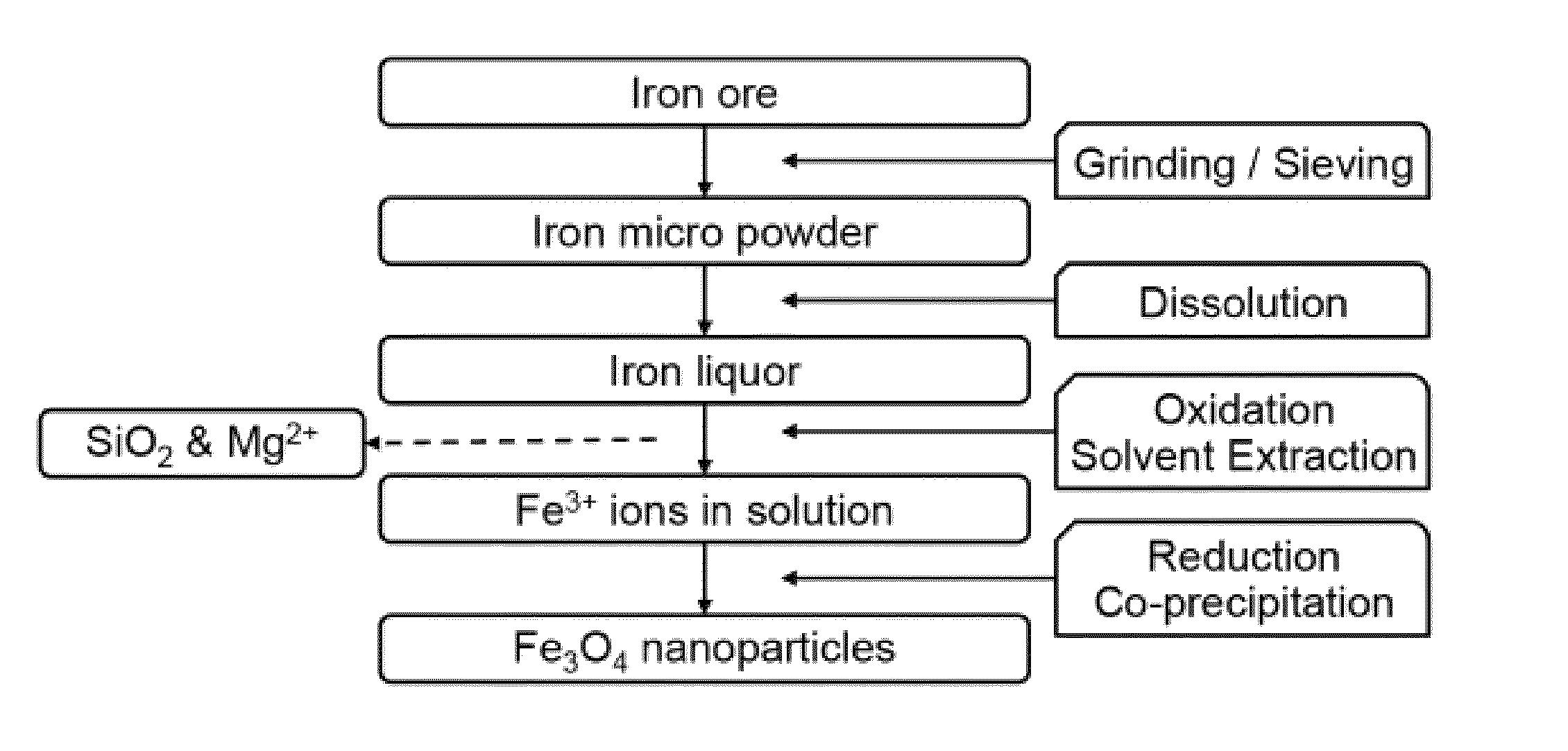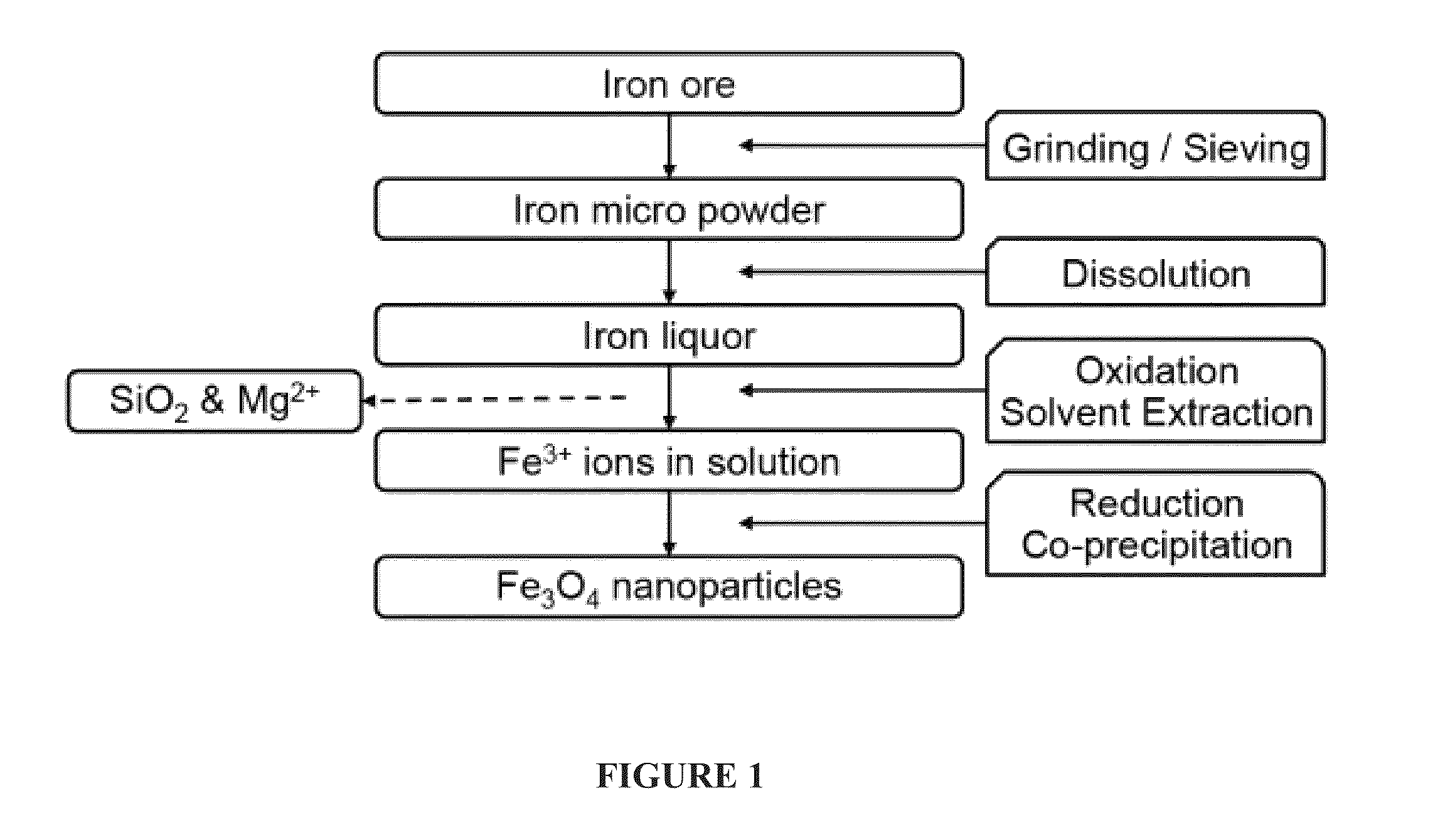Method for preparing magnetite nanoparticles from low-grade iron ore using solvent extraction and magnetite nanoparticles prepared by the same
a technology of low-grade iron ore and magnetite nanoparticles, which is applied in the field of preparing magnetite nanoparticles from low-grade iron ore using solvent extraction and magnetite nanoparticles prepared by the same, can solve the problems of high-purity iron salts, complex and costly process of preparing nano-materials by synthesizing high-purity iron salts such as iron, and achieves high magnetization, inhibits the formation of magneti
- Summary
- Abstract
- Description
- Claims
- Application Information
AI Technical Summary
Benefits of technology
Problems solved by technology
Method used
Image
Examples
example 1
Preparation of Magnetite Nanoparticles from Low-Grade Iron Ore
[0045]After crushing magnetite iron ore, magnetite powder less than 149 microns was sieved through a No. 100 sieve. To obtain magnetite leachate, 300 g of magnetite powder and 450 mL of 11.5 M hydrochloric acid were placed in a 1 L beaker and stirred at 100° C. for 2 hours. The obtained leachate was centrifuged at 10,000 rpm for 10 minutes to separate and discharge residual undissolved powder. To 300 mL of the obtained supernatant was added 390 mL of 30% H2O2 as an oxidant such that all Fe2+ ions were oxidized to Fe3+ ions, and 810 mL of distilled water was added to prepare a diluted aqueous solution in which the concentration of Fe3+ ions was 0.75 M. Then, a high-purity iron aqueous solution was obtained by selectively removing Fe3+ ions from the leachate, in which various metal ions were dissolved, using solvent extraction. In order to selectively extract the Fe3+ ions from the leachate, 250 mL of leachate (i.e., an aqu...
experimental example 1
Wet Chemical Analysis and Inductively Coupled Plasma Atomic Emission Spectrometry (ICP-AES)
[0048]The compositions of the magnetite nanoparticles prepared in Example 1 and the raw iron ore powder were measured by wet chemical analysis and inductively coupled plasma-atomic emission spectrometry (ICP-AES, Jobin-Yvon, JY 38 plus, France), and the results are shown in Table 1.
[0049]
TABLE 1Concentration of elements (wt %)Raw iron oreMagnetite nanoparticlesCompositionpowderReagentSolution obtained from iron oreFe76.8599.1799.49Si7.260.290.18Mg11.490.030.02Al1.390.180.20Ca1.630.070.10Mn1.180.260.00Zn1.110.000.00P0.01Ti0.080.000.00Total100.00100.00100.00
[0050]Among the major metal components, the weight ratio of Fe increased from 76.9% in the raw iron ore to 99.5% in the sample of Example 1, which is the same level as 99.2% in nanoparticles prepared from commercially available iron salts. The contents of Si and Mg that inhibit the formation of magnetite nanoparticles were 7.26 wt % and 11.49...
experimental example 2
Transmission Electron Microscope
[0051]Images of magnetite nanoparticles prepared using low-grade iron ore according to the present invention and using a commercially available reagent, taken by a transmission electron microscope (Philips, CM12, Netherlands), are shown in FIG. 2.
[0052]As shown in FIG. 2, it can be seen that the shape of the magnetite nanoparticles prepared using the commercially available reagent is substantially the same as the nanoparticles prepared in Example 1 and that the average sizes are 11.0 nm and 10.8 nm, respectively, which are almost the same.
PUM
| Property | Measurement | Unit |
|---|---|---|
| wt % | aaaaa | aaaaa |
| volume | aaaaa | aaaaa |
| volume | aaaaa | aaaaa |
Abstract
Description
Claims
Application Information
 Login to View More
Login to View More - R&D
- Intellectual Property
- Life Sciences
- Materials
- Tech Scout
- Unparalleled Data Quality
- Higher Quality Content
- 60% Fewer Hallucinations
Browse by: Latest US Patents, China's latest patents, Technical Efficacy Thesaurus, Application Domain, Technology Topic, Popular Technical Reports.
© 2025 PatSnap. All rights reserved.Legal|Privacy policy|Modern Slavery Act Transparency Statement|Sitemap|About US| Contact US: help@patsnap.com



